The Science of the Sun, Sun Tanning, Nuclear Fusion and Fission Power
Rutherford Appleton Laboratory astrophysicist Dr Chris Davis joins us to shed light on the structure and workings of the sun and the newly-launched STEREO mission, Cambridge University engineer Dr Jeffery Lewins talks about nuclear energy and the differences between fusion and fission power, and Dr Anna Nicolaou from the University of Bradford asks why do some people burn whilst others turn brown? On a practical level, in Kitchen Science, Derek and Dave lift the lid on how suncream works.
In this episode
Atomic Tweezers
Scientists from the University of Bonn have constructed the world's smallest pair of tweezers which are capable of moving atoms around one by one and might hold the key to superfast "quantum computers" of the future. In this week's Nature, Arno Rauschenbeutel and his colleagues describe how they have used two intersecting laser beams to position individual atoms from a cloud of cooled caesium. The lasers are set up so that they each generate a standing wave - literally a series of peaks and troughs - and the result is that the caesium atoms arrange themselves at the crests, which are about one two-thousandth of a millimetre apart. Then, by pulsing the laser so that the peaks and troughs move along the beam, the atoms can be carried forwards and backwards. The second laser beam, which points upwards, can then use the same trick to move the atoms up and down. In this way it's possible to achieve highly-precise positioning of individual atoms in three-dimensional space, and then read their position using a laser tuned to the right frequency. This atomic abacus could in turn be used to rapidly store and retrieve quantum information, which will be necessary to build more powerful microprocessors in the future.
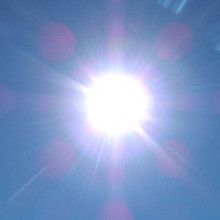
How does sun cream work?
With the summer holidays approaching, Derek and Dave head off to Hinchingbrooke School to find out why wearing the white stuff is the cool thing to do.
To do this experiment, we used:
A low power ultraviolet (UV) light in a black box Washing powder tablets Piece of white paper Day - glow pen Sun cream
How to do the experiment:
1 - Take a washing powder tablet and put it under the UV light. What do you see? Do the same with the piece of paper and compare it to the washing powder tablet.
2 - Take a day-glow pen and draw a picture on your hand.
3 - Put your hand underneath the UV light. What do you see?
4 - Smear sun cream over half of the picture on your hand and put your hand back under the UV light. What happens now?
What happened?
When washing powder tablets are put under UV light, you can see that some of the powder glows blue. A white sheet of paper will also glow blue under UV. Why? Because the people who make washing powder and paper cheat!
Despite what the adverts say, it is very difficult to transform grubby clothes into dazzling whites with nothing but elbow grease. To get around this problem, washing powder manufacturers add a special substance (called an optical brightener) that absorbs UV light.
Ultraviolet light, a part of the electromagnetic spectrum, is not visible to the human eye and is slightly more energetic than the blue and purple frequencies of visible light. When UV light is absorbed by the optical brightener, some of it is re-emitted but at a lower energy level. This lower energy level is the same as the blue and purple frequencies of visible light, which is why we can see it.
Converting the invisible UV into blue light makes the clothes look brighter and gives the impression of being whiter than white.
However, the light given off doesn't have to be blue. Depending on the substance, the light re-emitted under UV can range from blue, to green and even pink. You can see this in day-glow pens. These desktop staples also convert UV light into a colour which we can see, and even work under UV light from the sun. This is why they're called day-glow: they will work under the natural light of day but not a light bulb at night!
But what's all this got to do with sun cream?
If you draw on your hand in day-glow pen and put it under UV light, it will glow blue, pink or green - depending on the pen. If you then cover half the picture in sun cream, the half with sun cream will stop glowing.
The pen stops glowing because sun cream blocks ultraviolet light. If UV light can't be absorbed by the substance in the pen (the equivalent of an optical brightener in washing powder), then it can't be re-emitted at a lower energy level and thus the pen won't glow.
Sun cream can block ultraviolet light by either reflecting or absorbing UV. This is important for human health because when UV light reaches the skin it can cause skin damage, sun burn and in some cases, skin cancer.
But sun cream won't block all of the UV light. The 'factor' of your sun cream is a measure of how good it will be at stopping the UV - theoretically, factor 15 will reduce the amount of UV reaching your skin by a factor of 15, and so on.
So if you want to stop sun burn or prevent embarrassing moments when someone draws on you in a nightclub, slap on the sun cream!
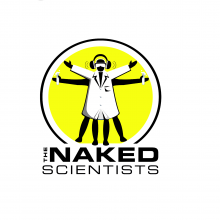
- Paralysed Let Their Thoughts Wander...
Paralysed Let Their Thoughts Wander...
with Dr John Donoghue, Brown University
Chris - Now take a listen to this… that was actually the sound of brain cells, neurons, firing off and talking to each other. It's been done by a man called John Donoghue at Brown University, and he's found a way of making an electrode that can be inserted into the brain of an individual. In this instance they've put this electrode into the brain of a man called Matthew who's been paralysed for the past few years because of a spinal cord injury. What the researchers are trying to do is to record that activity you just heard and then use a computer to decode it so that Matthew can re-establish the ability to move. So using a computer he can control things in the environment and maybe even, in the future, get the computer to do the job of the muscles that have been disconnected from his brain by the paralysis. This is John Donoghue talking about how this research works.
John - The paper is about the technology that we've developed to help a paralysed person communicate with the outside world again, to be able to use their thoughts and for their brain activity to control devices, and mainly what we used was a computer.
Chris - So is this literally recording from individual nerve fibres or is this whole populations of nerve cells that you're listening to?
John - We're recording individual nerve cells, we're recording what's called the spiking activity, which is the language of the brain, and we record many of those at once - dozens to more than 100 - and we transform the pattern of spiking activity into a single control signal.
Chris - So in order to record from the hand area of this person's brain you actually, presumably, have to implant an electrode?
John - An electrode array is implanted. Yes.
Chris - So what does that look like and how does it work?
John - The array is about the size of a baby aspirin and it's implanted on the surface. It's 4 x 4 millimetres and it has 100 hair-like protrusions coming out of it. They go just into the surface of the brain, the cortex is about the thickness of an orange peel and the electrodes go about half that thickness into the brain to pick up the neurons that are just below the surface.
Chris - And then how is that translated by your computer into a meaningful movement? And does the subject have to learn to control this?
John - There's not actually a learning required to control it, the part that has to be learned is the relationship between a complex pattern of activity that's coming out of the brain and a desired motion of the cursor. So we have the patient imagine that they're tracking a cursor on a screen, and by the changes in brain activity that we observe while that patient is observing the cursor motion we build a map that says, here is the pattern of activity and here's the cursor position, and later on, here is another pattern of activity and here's another cursor position, and we try to map the two together. And of course another significant finding is we're able to do that. We do it over a period of about 15 minutes or so. So that's not really learning, it's establishing the mapping function. Once that mapping function is put together in the computer then the patient is able to just think about moving and the cursor will move pretty much in the motion that the hand would take if you were to imagine, say, moving left or right.
Chris - How accurate are the movements that the person who has the implant fitted can make?
John - So the motion of the cursor by thought is I would describe as wobbly and unstable, so right now, if your mouse performed like that it would be rather frustrating. And that's actually been part of our study, is to understand what happens as a person is exposed to that kind of signal? Do they get better and better at controlling it? And so far we haven't seen a major change in their control. And what that means is that at least we haven't found out how to exploit the brain's plasticity, so we need to change the computer to make the control signal better. And we're doing that and actually having some good success.
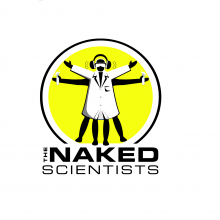
- Science Update Frog's Legs and Gunshots
Science Update Frog's Legs and Gunshots
with Chelsea Wald and Bob Hirshon from AAAS, the science society.
Kat - We're now going to go over to the US to hear from Chelsea and Bob with our Science Update. They're going to talk about frogs eggs that literally leg it when a hungry snake slithers by, and a robot called Red Owl who can pinpoint the source of gun shots on the battlefield.
Bob - This week for the Naked Scientists we'll learn about a technology that mimics human hearing and could help soldiers on the battlefield. But first, in nature eggs are sitting ducks, but Chelsea learned that some types of eggs may not be as helpless as they seem.
Chelsea - It's hard to imagine your breakfast egg running away from a predator but the eggs of the red eyed tree frog can do just that. Biologist Karen Walkentin of Boston University has found that these eggs hatch prematurely when an egg is in imminent danger from a snake.
Karen - And it's a very rapid behavioural response. The snake starts biting and within seconds to a couple of minutes the tadpoles will bale out. Up to 80% or so can escape from the snakes.
Chelsea - But premature tadpoles don't face good odds, so they need to be able to tell a real snake from a false alarm.
Karen - It's such a big decision for them and it's a question of death in one place versus death in another place.
Chelsea - Their secret? Walkentin's experiments show that the eggs use vibrations to distinguish between snakes, wasps, rain and wind and are accurate even when the vibrations are similar.
Bob - Thanks Chelsea. A robot called Red Owl may soon help soldiers locate the source of gun shots. It's based on sound processing technology originally designed to improve cochlea implants for deaf people. New field tests show that this new technology can accurately identify and log the locations of many shots in rapid sequence, like those on a battlefield. Engineer Socrates Deligeorges of Boston University says that it's modelled after the way humans and other mammals hear.
Socrates - Basically neuron by neuron, how the mechanical structures take sound pressure waves, how the brain converts those to electrical signals and how the brain uses those electrical signals.
Bob - Once Red Owl locates the source of the gun shot it turns to the shooter and zooms in with a camera. Although it could still be a while before Red Owl makes it to actual battlefields, Deligeorges says the sound processing technology has proved useful in many other situations. These include monitoring machinery and even taking a census of frogs.
Chelsea - Thanks Bob. Next time we'll learn about scientists developing replacement retinas that use chemicals to communicate with the brain. Until then, I'm Chelsea Wald.
Bob - And I'm Bob Hirshon for AAAS, the science society, Back to you Naked Scientists.
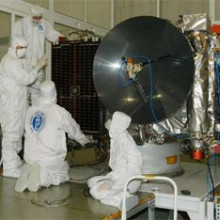
- Seeing The Sun in Stereo
Seeing The Sun in Stereo
with Dr Chris Davis, Rutherford Appleton Laboratory
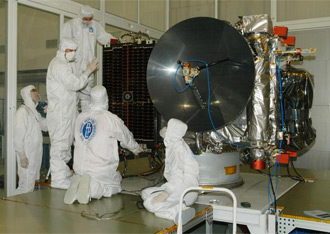 |
| STEREO spacecraft A |
Chris S - Thanks for joining us tonight to talk all about the sun. It's something that we very much take for granted. I remember a mathematics probability textbook I had that said, 'There are some things that are certain, such as the sun rising tomorrow. Probability equals 1.' But what actually is the sun and is it always going to rise?
Chris D - Well it's our nearest star. The Sun is a huge ball of mainly hydrogen gas and it's burning this hydrogen by the process of nuclear fusion to form helium. As far as we can tell it's been burning for the last four and a half billion years and will continue to burn for another four and a half billion years, so that's as near to a probability of one as you can get I would think.
Chris S - The reason the Sun is losing weight comes down to Einstein and e=mc^2 doesn't it?
Chris D - Well it certainly is losing weight because it's sticking hydrogen atoms together to make helium atoms and that releases energy and you can convert energy to mass using the famous e=mc^2 relationship. But it's atmosphere is so hot that it's boiling. It's like looking at a pan of boiling water and the steam rising from the surface. That's because those particular particles have enough energy to leave the fluid in the saucepan, and it's the same with the surface of the Sun. If you look at it with special cameras in space you can see that it's just a writhing mass. It looks likes a pan of rice on the boil and this can send material into space in a continuous stream known as the solar wind.
Chris S - One statistic I've heard is that it takes 8 minutes for light from the Sun to reach the Earth. But then I was speaking to a professor of astrophysics who said that the light we're getting out of the Sun is already a million years old and it's been bombarding itself all around inside the Sun a million years before it escapes and makes its way in that 8 minutes to us.
Chris D - Well yes, the 8 minutes is in consequential. The light is generated in the centre of the Sun, as it is only here where the temperature is great enough and the pressure is great enough to actually produce the nuclear reactions that can fuse hydrogen into helium. The material is so dense there that the light that's given out is immediately absorbed by something else, emitted again and absorbed by something else. So it's an incredibly large arcade game where this thing is being ricocheted backwards and forwards inside the Sun. It does take about a million years for that one single photon of light to get from the centre out to the surface where the density of gas decreases to the extent where the material becomes transparent and it can shine out into space.
Chris S - Can we talk a little bit about what's going on at the centre of the Sun to power it? What is the process that's happening and how is it doing that?
Chris D - The Sun is an enormous ball of gas and it's being pulled together under its own gravity, which is then squishing the materials in the centre to incredible densities. This actually forces the particles in the soup so close together that they can actually fuse to form to a helium atom from two hydrogen atoms. The temperature is at about 16 million degrees at the centre of the Sun so you have to have this huge ball of gas pressing down on it to produce all the conditions necessary. When you take two atoms and join them together, you release energy and that's what gives the Sun the light and the heat that it emits.
Kat - So how do we actually measure things about the Sun like its size and its heat and the light that comes out of it?
Chris D - Well there have been lots of observations that have been going on for many hundreds of years because the Sun was obviously a religious object for people like the Aztecs and the Egyptians. So we've got a lot of information about the Sun and particularly solar eclipses and that tells us about the solar atmosphere for example. When the moon moves in front of the Sun it blocks out a large disc and allows us to see the feint solar wind which is the gas blowing out into space. So they made observations like that and were able to predict solar eclipses. But as we've moved towards the space age, we can actually start to look at the Sun in different wavelengths. The Sun is the colour it is because the surface of the Sun is at about 5800 degrees. The colour tells us the temperature. This is just like a blacksmith who knows when the metal is the right temperature because it is white hot or red hot. He uses the colour the hot metal is producing to tell him what temperature it is.
Kat - And how do we study other things about the Sun? What exactly are solar flares and sun spots and all these weird phenomena that are associated with the Sun?
Chris D - Well the Sun is like most stars and has a magnetic field like the Earth. That magnetic field is pretty stable and we know it flips up and down every hundred thousand years. But the Sun is a fluid and it has peculiar properties. The equator of the Sun rotates about every five days while the poles of the Sun rotate every thirty days.
Kat - Tell us a bit now about the new mission you're working on called STEREO. What's all this about?
Chris D - With the space missions we've been sending out of late, we've been getting a much more detailed view of the surface of the Sun. You can get active regions on the surface of the Sun where the Sun's magnetic field gets contorted and twisted and pops out through the surface of the Sun. It's these that are the root of solar flares and also are the root of things called coronal mass ejections. These are a very violent storms that come out into space and ascending dense clouds of this gas towards us. But the trouble is that we want to be able to predict these coronal mass ejections and the direction they're going to go in and how fast they're travelling. Although SOHO has been a very successful mission, it's only one view in space, and it's very difficult to deconstruct that convoluted 3D nature. So with the STEREO mission we're going to send two spacecraft out: one ahead of the Earth's orbit and one just behind the Earth just inside the Earth's orbit. After a couple of months they'll be far enough apart that they can look back at the Sun and view the Sun in three dimensions and try to work out this complicated twist of spaghetti loops that you can see coming out of the surface.
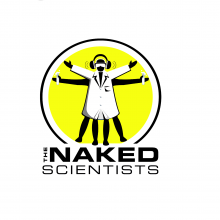
- Nuclear Energy: Fission And Fusion
Nuclear Energy: Fission And Fusion
with Dr Jeffery Lewins, University of Cambridge
Chris - Nuclear power has had a mixed reception from the public and certainly a hostile reception this week in the wake of the government's publication of what they think should happen on the nuclear debate. But first of all, what actually is nuclear power, how does it work and what's the future?
Jeffery - We've heard about the fusion going on in the Sun and that's that great nuclear reactor in the sky. The light and the heat we get from the Sun is essential to the Earth already. You could hope to build a fusion reactor on Earth, but it's a real problem because we don't have the mass of the Sun, the gravity to make it work. We have to substitute it with a magnetic field and that's expensive. It's great science and challenging engineering but I think having been in the business for fifty years, I'd still say that success is fifty years away if you mean by success that you get useful electricity back from fusion power. Now the other end from what Chris said is fission power. In the Sun they're putting very light elements together and getting energy out of it. But here on Earth we get heavy elements like uranium and thorium and if you split them up into fission products you also get neutrons left over, these are what cause the fission in the first place, and energy. It's that energy that for the last fifty years people have employed. Of course, some of this has been in weapons and we don't want to see that, but some has been employed in nuclear power stations to make electricity, which we have a substantial amount of in this country and other places in the world.
Chris - But why is fusion viewed as better than fission?
Jeffery - Perhaps because it's fifty years further down the line is one answer. But it doesn't produce the associated materials such as plutonium, which comes out of fission reactors when uranium is converted into plutonium. Plutonium can also be burned in fission reactors but it is also one of the roots into nuclear weapons, and I think there's a concern there. But to be fair, fusion energy produces a lot of neutrons, it produces a lot of radioactivity and don't think that's it's the clean thing that some people would like you to think it is.
Kat - Nuclear power is very controversial and over the past nine weeks or so I've been involved in writing a blog for the Institute of Physics which is looking at all the issues surrounding nuclear power, especially in light of the UK's energy review. So you can go and have a look yourself and hear all the arguments. It's at www.potentialenergy.iop.org and it's looking into the science, the economics, the politics, so go along and make some of your own comments.
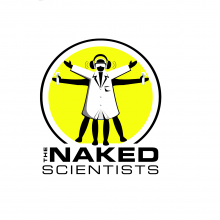
- The Science of Sun Burn
The Science of Sun Burn
with Dr Anna Nicolaou, University of Bradford
Chris - What is sunburn?
Anna - Sunburn is damage to the skin to the extent that you overwhelm the natural defence of the skin. In the same way that you get burnt when you go very close to a naked flame or a hot hob, it's the same way if you expose yourself to radiation from the Sun. It has a lot of energy.
Chris - Because it's all down to UV isn't it? So what's the difference between UVA and UVB and you even hear people talking about UVC? What is that?
Anna - The Sun sends to Earth different types of energy in different forms of radiation. We're quite lucky that the atmosphere blocks the most dangerous one: UV form C. But UV radiation form B travels through the atmosphere. It carries a lot of energy and mainly causes sunburn and gives cancer eventually.
Chris - So when the UV hits our skin, what's it actually doing to provoke burning and subsequent skin cancer?
Anna - It stimulates a natural process, a natural defence system in our bodies called inflammation. All this redness you get and the pain and sometimes swelling is a result of inflammation. Your body is trying to compensate for this damage that has happened to the skin. This is called inflammation and the redness and everything that comes with it are the classic symptoms. This is how we exhibit sunburn to start with.
Chris - Are some people more prone than others?
Anna - They are indeed, and we don't quite know why this is. We know that some people tan and that some people burn. We know that if some people spend half an hour in the sun, the next day they will have a nice brownish colour. Other people will be red like a tomato. It's all down to the natural ability of our skin to produce a dye that is called melanin. This is produced by a type of cell called a melanocyte, which we all have normally in our skin. But in some of us they give a nice pigment and you tan and in others of us they don't seem to be doing the same job and we get more red. We still don't know what it is that makes these melanocytes behave differently from person to person.
Chris - Your research is looking specifically at prostaglandins. What are they and what's their role in this?
Anna - Prostaglandins are some small compounds that our system is producing to show inflammation. To give you an example, you have a headache and you attribute pain. It's because inflammation is happening. You have an aspirin and you block the headache. So prostaglandins are this naturally occurring compound that causes inflammation and makes you feel bad. This is what we're trying to relate to the melanocyte.
Chris - So just in the last few seconds, what about aspirin and things? What's your research going to hopefully achieve?
Anna - Hopefully we'll be able to see why it is that some people burn instead of tanning, and we'd eventually like to develop a drug or therapy or something like aspirin that people can take and stop this redness occurring. Or we could give them some advice to prevent them from getting in this painful situation.

- Does lemon juice bleach hair?
Does lemon juice bleach hair?
The answer to this is acid catalysed oxidation. If you add oxygen and ultraviolet light to most things, like hair or clothes, then they will bleach. If you're out in the summer sun, there's oxygen in the air and sunlight, so your hairs go blond. Adding lemon juice to your hair means that you are adding an acid, and that just speeds up the bleaching process.

- Why is a chilli called a chilli when it's hot?
Why is a chilli called a chilli when it's hot?
We couldn't answer this question last week, but I'm pleased to tell you that Jose Fernandez in Mexico City has been listening to us on the internet. He says that the name comes from the Spanish word 'chile', which has its own roots respectively in the Nahuatl language (the Aztecs spoke a variant of this). So a chilli was originally called chile in Nahuatl. The Spanish then took this into their own language and the English language borrowed it from them. So the fact it is called a chilli has nothing to do with its temperature at all - it's just the word that was originally used for it in another language.

- Is the Sun shrinking?
Is the Sun shrinking?
It's certainly shrinking because it's giving off matter into space all the time. It's known as the solar wind. But this is a tiny fraction of the mass of the Sun and it's certainly not going to evaporate off into space before it's used up all the fuel. One statistic I did hear is that it sheds one million tonnes per second. The numbers are so big that it's difficult to equate what they are, but it's the equivalent of the mass of a reasonable sized mountain per day.

- How do magnetic fluctuations in the Sun affect our climate?
How do magnetic fluctuations in the Sun affect our climate?
We've come a long way with this science recently. The reason for this is that the Sun has a magnetic field and the magnetic field goes out into space in the solar wind. That affects planets with a magnetic field. If you put two magnets together they will either repel or attract depending on whether they are the same or opposite. If the Sun's field in space is the opposite sign, those two fields can join together and some of this very hot gas can fall into the Earth's atmosphere. This is what is known as a geomagnetic storm. If you are measuring the Earth's magnetic field from the ground you start to see your compass needle get a bit confused because the magnetic field of the Earth is being moved about and altered by being connected to the Sun's magnetic field.

- What's the deal with fusion as a power source?
What's the deal with fusion as a power source?
Well let's start with cold fusion. This was reported fifteen or more years ago as an interesting product where you didn't need big magnetic fields but you had electric currents passed into liquids. Somehow they suddenly gave energy off. Whether this is really fusion or whether this is just one of those funny things about electricity, I don't think has been fully demonstrated yet. But if you want to go to the more general idea of fusion as it is on the Sun, I think you have to say that on Earth we've been able to demonstrate fusion for a few fractions a second, a few milliseconds. We've never got electricity out of it; we've always put a lot of electricity into it and I think it's a very challenging thing that we haven't cracked.

- Where does the shadow on the moon come from?
Where does the shadow on the moon come from?
The reason for that is that the Moon is at an angle to the light arriving from the Sun, so only part of the lunar surface - the part facing the Sun - is illuminated. Imagine shining a torch at a football - you would see the surface of the ball facing the torch illuminated and a curved edge to the illuminated patch. Behind this the ball would be poorly- or un-lit. The Moon's the same. And because it orbits the Earth, taking 1 month to do so, at different points in its orbit more, or less of the surface is facing the Sun, so the illuminated zone enlarges or shrinks accordingly. When there is a "new" Moon, that moon is between us and the Sun, so none of the surface that we can see is being lit at all, so it's invisible against the dark sky.

- Is lack of sun exposure leading to SAD syndrome?
Is lack of sun exposure leading to SAD syndrome?
This is a really interesting debate. There are some people in the media who are saying that we need to get out in the sun as much as possible. It's really difficult because being exposed to too much sun, particularly burning, really does increase your risk of developing skin cancer. We know this from research and rates of skin cancer are set to treble in the UK as a result of too much sun exposure. But we do make vitamin D in our skin when sunlight hits our skin and we can also get vitamin D in our diet. Vitamin D is very important for building healthy bones and teeth and things like that. Deficiency in vitamin D can cause rickets and there's some evidence that it may help to prevent against cancer. So it's a difficult message to try and get across. Yes, it's important to be safe and not to burn in the sun, but at the same time you should try to be sensible about it. Don't go out in the middle of the day when it's really hot, but you'll still get enough sun to keep your levels of vitamin D healthy. SAD is another point, and it causes some people to become depressed if they don't get enough natural bright sunlight. It's not the same as not getting enough vitamin D or over exposure to the sun. It's a slightly different phenomenon.

- What range of frequencies of electromagnetic radiation are produced by the Sun?
What range of frequencies of electromagnetic radiation are produced by the Sun?
The light that comes from the Sun would be in a continuous spectrum and it's dictated by the temperature of the Sun. The colour tells you what temperature it is. From the Sun's photosphere, the rays of light go from x-rays through visible light all the way up to radiowaves, but they peak at around 550nm, which is yellow light. It peaks in the visible part of the spectrum. That would be continuous were it not for the fact that there are discrete energies that are absorbed and emitted by the different atomic species on the Sun. For example, the element helium was discovered by astronomers noticing that there was a gap in the spectrum that corresponded to an element that they previously didn't know about. So they called it helium after the Greek god Helios.

- Can we harvest electricity from the radio waves emitted by the Sun?
Can we harvest electricity from the radio waves emitted by the Sun?
I wish it was! The total energy we get in every square metre on the surface of the Earth from the Sun is about 1kW. If we could turn all of that into electricity, that would be marvellous. But I'm afraid the laws of thermodynamics stop that. The temperature of the Sun isn't so great as to turn it all into possible work, and antennae would just pick up very faint signals like the old early radio waves when you had a crystal set and got a weak signal. I'm afraid it isn't going to be useful to turn that into practical energy to power your house.

- How does light actually propagate?
How does light actually propagate?
It is indeed one of those mysteries! Light can travel through a vacuum, so it doesn't require anything to push it forward with. You can think of light as particles or photons and also as a wave. In fact, it behaves as both at different times! Put simply, light is an electromagnetic wave; so you get a changing electrical field, which in turn produces a changing magnetic field, which in turn produces a changing electrical field. This propagates indefinitely through space, at the speed of light, until it interacts with something.

- Does the Sun move through space?
Does the Sun move through space?
The Sun does move. We're orbiting our galaxy; we're on one of the spiral arms of the galaxy. We go round about every 240 million years so our whole solar system is moving. But relative to our solar system it sits at the centre of the solar system and is so massive that it controls the movement of the planets. It sets the orbits of the planets.

- Why do you sneeze when you look at the Sun?
Why do you sneeze when you look at the Sun?
This is a reflex called the photic sneeze reflex and no-one's exactly sure what underlies it. We know that it's genetic and is passed on in families. About one person in four or one person in five is affected. People used to think that when you looked at the Sun, the bright light made your eyes water, the water ran down into your nose, tickled your nose and made you sneeze. This is not true because it happens too fast. What scientists think is that there's some sort of crossed wiring in the back of the brain where the size of your pupil is controlled, and that's what causes that to happen.










Comments
Add a comment